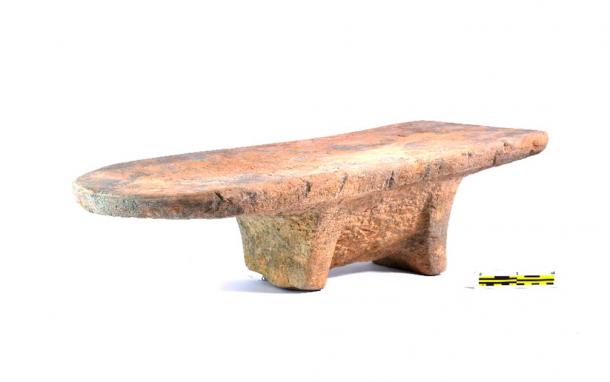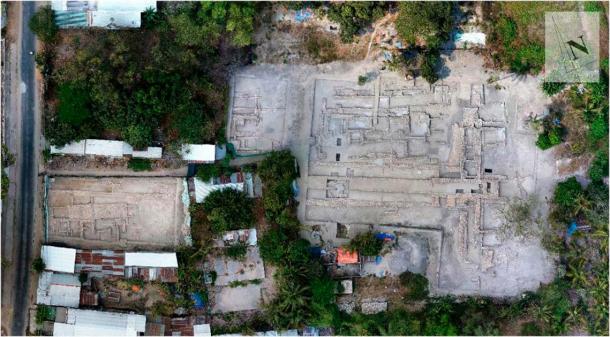
Oldest Evidence of Southeast Asian Curry Found in Vietnam
The ancient spice trade across the famed overland and then maritime Silk Route (Road) has been studied in great detail, but the finer intricacies of organic material have oft been overlooked for lack of preservation. Now, from the Óc Eo archaeological complex in southern Vietnam, evidence of Southeast Asia’s oldest curry, dated to 2,000 years ago, has been identified. This is the oldest evidence of curry found outside India!
Analyzing the Remnants of Spice and Organic Matter
Through the analysis of plant remains and 717 grains of starch that were recovered and extracted from 12 ancient stone grinding tools uncovered at the site, researchers identified traces of rice, as well as a rich array of spices, including turmeric, ginger, fingerroot, sand ginger, galangal, clove, nutmeg, and cinnamon. They compared and analyzed these spices against a wide array of almost 200 spices.
To their surprise, the nutmeg seeds recovered from the site were still aromatic two millennia later! Starch grains from turmeric and ginger were the most abundant out of the 8 spices uncovered from the site. These grains displayed broken features, and were likely finely ground, making them akin to the starch granules found in modern curry powder.
- Three Ancient Diets That Are Still Popular Today
- Nutmeg Poisoning: A Deadly Addition to the Kitchen Cabinet?
“We discovered a wide variety of spices that had travelled from different locations to Óc Eo,” said Dr Hsiao-chun Hung of the Australian National University, who led the excavation and research. “All of these spices reached Vietnam 2,000 years ago, contributing to the creation of delightful dishes that must have been enjoyed by the people of that time.” This research has been published in the latest edition of the journal Sciences Advances, and also highlights the earliest known evidence of spice processing from this region.
The cookware from where the evidence is recovered resembles an anvil in size and shape, and is believed to have been used for grinding spices. The site is situated amidst ancient canals in the southwestern Mekong Delta. This location was once a prominent port of the Funan kingdom, which thrived from the first to seventh century C.E.

A footed grinding slab is excavated in southern Vietnam in 2018. (Khanh Trung Kien Nguyen/Southern Institute for Social Sciences, Vietnam)
“The preservation of plant remains in Óc Eo is exceptional,” says Australian National University archaeologist and study co-author. She suspects that the humid climate of southern Vietnam helped shield the remains from degradation. “When we uncover the seeds from the muddy soil for the first time, they appear remarkably fresh, making it difficult to believe that they are nearly 2000 years old.”
Southeast Asian Curry, Tools, and the Indian Connection
The most prominent amongst the stone tools, which included mortars and pestles, was the aforementioned anvil-shaped 75-centimeter (29.5 inch) long footed grinding slab made of sandstone. It resembles similar implements still employed today for making spice paste. Notably, similar objects have been found in ancient Indian sites, according to the archaeologists who conducted the analysis of the implements between 2017 and 2019.
There has long been an awareness of the strong Indian impact on Southeast Asian communities. This influence was evident in architectural, linguistic, and religious similarities during that era. The recent study, however, has provided "rock solid evidence" of this influence extending into the realm of cuisine, reports Science.

A sandstone grinding slab found at Óc Eo in Vietnam, on which traces of spices were identified. (Trung Kien Nguyen)
With compelling archaeological evidence, the origins of curry can be traced back to India over 4,000 years ago (even though there is no evidence of the word ‘curry’ itself being used – it was likely a colonial misunderstanding). This culinary heritage is supported by the discovery of spice residues, along with remnants of eggplant and mango, found adhered to human teeth and in ancient cooking pots.
“Before this study, we had only limited clues from ancient documents in India, China and Rome about the early spice trades. However, this research is the first to confirm that these spices were indeed traded commodities that existed within the global maritime trading networks nearly 2,000 years ago,” added Hsiao-chun Hung.
The site of Óc Eo, having been excavated since the 1940s, has yielded numerous artifacts indicating that the city was a central hub in an extensive trade network that stretched as far as the Mediterranean Sea.

Aerial view of brick foundations at Go Sau Thuan in the Óc Eo complex. (Khanh Trung Kien Nguyen)
The Lasting Essence of Curry Flavors
The combination of spices found at Óc Eo remains integral to Southeast Asian curries today. However, the term "curry" might not capture the vast array of the region's culinary diversity accurately. This word originated from European colonists, who used it broadly to refer to spiced dishes from southern Asia.
In reality, "curry" can take on various forms, and understanding the intricacies of different regional cuisines was crucial in the analysis of Khanh Trung Kien Nguyen, an archaeologist at the Southern Institute of Social Sciences in Ho Chi Minh City, who collaborated on the study.
The recipes brought to Vietnam by traders underwent local modifications with the addition of familiar ingredients, leading to the development of a unique culinary tradition. While many spices found at Óc Eo were probably imported, others are indigenous to Southeast Asia.
- Saffron: Tracing the Origins of a Treasured Ancient Spice
- Mediterranean Cultures Imported Asian Exotic Foods Before 1700 BC
For instance, certain varieties of ginger, commonly used in Thai and other Southeast Asian cuisines, are rare in similar Indian dishes. The recovery of coconut traces from the tools further suggests that spices at Óc Eo were thickened with coconut milk, a technique characteristic of modern Southeast Asian curries.
Several spices found at Óc Eo, like clove and nutmeg, are native to South Asia and eastern Indonesia. Their presence in an ancient Vietnamese city indicates that travelers from these regions likely introduced their traditional recipes to mainland Southeast Asia during the early centuries C.E.
Some of these journeys covered thousands of kilometers, highlighting Southeast Asia’s centrality and role in the missing chains of human development. In the annals of human history, it clearly served as a crossroads for migrants, merchants, and travelers from different places.
“The curry recipe used today has not deviated significantly from the ancient Óc Eo period,” concludes Nguyen, who notes that the use of turmeric, clove, and cinnamon has remained consistent over the centuries. “This continuity highlights the lasting essence of curry flavors in Vietnamese cuisine.”
Top image: The oldest evidence of Southeast Asian curry has been found in southern Vietnam. Source: Adobe Stock / Jasmina
By Sahir Pandey
References
Jacobs, P. 2023. Curry may have landed in Southeast Asia 2000 years ago. Available at: https://www.science.org/content/article/curry-may-have-landed-southeast-asia-2000-years-ago.
Lu, D. 2023. 2,000-year-old curry: scientists discover evidence of ancient recipe in south-east Asia. Available at: https://www.theguardian.com/world/2023/jul/22/2000-year-old-curry-scientists-discover-evidence-of-ancient-recipe-in-south-east-asia.
Wang, W., et al. 2023. Earliest curry in Southeast Asia and the global spice trade 2000 years ago. Sciences Advances, 9(29). Available at: DOI: 10.1126/sciadv.adh5517.
Wang, W., Hung, H. 2023. Researchers find evidence of a 2,000-year-old curry, the oldest ever found in Southeast Asia. Available at: https://theconversation.com/researchers-find-evidence-of-a-2-000-year-old-curry-the-oldest-ever-found-in-southeast-asia-210192.















